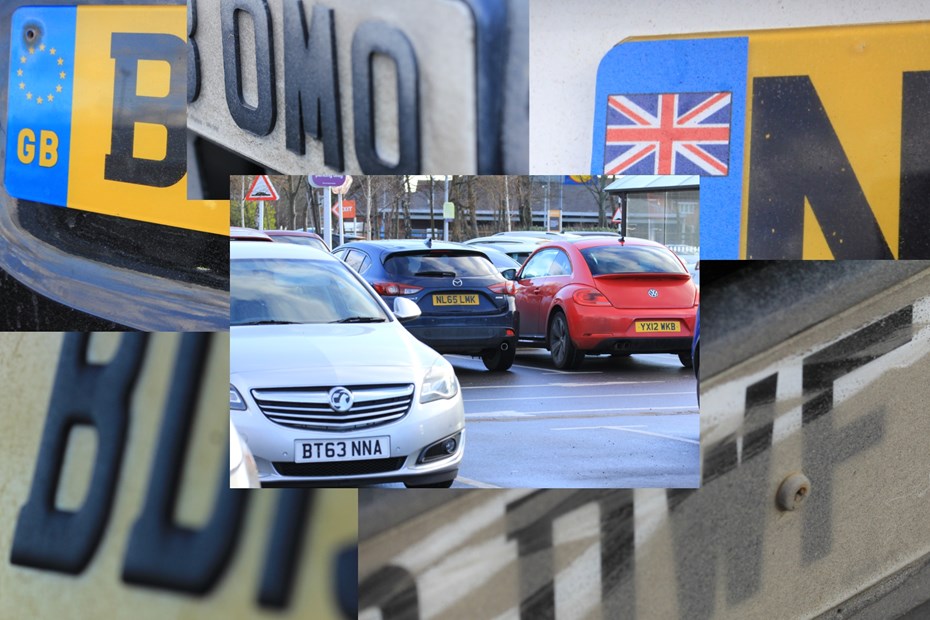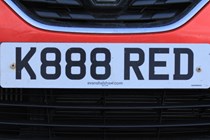Number plates have been a feature of cars for so long that it’s easy to forget they’re there – but they’re more complex than you might first expect. When buying a brand-new car or used car most people are happy to accept whatever plate is on the front and back when they get the keys, but some drivers like to stand out from the crowd and have personalised registrations and custom designs – but these still need to comply with Driver and Vehicle Standards Agency (DVSA) criteria.
Fail to comply and you could find yourself in trouble with the police, dealing with paperwork hassle, or in extreme cases, have your car taken off you. It’s well worth familiarising yourself with the legalities of number plates as a result.
In this guide, we explain what a legal number plate looks like, what features are allowed and restricted, the correct fonts and spacing, and whether those ubiquitous 3D and ‘4D’ plates are legal or not. You can also read about how cleaning your car can make a difference, and what those new green plates mean.
With road policing units seizing non-compliant number plates nationwide, and the government bringing in greater use of Automatic Number Plate Recognition (ANPR) to fine drivers for misdemeanour offences, it might be worth your while to brush up on what is and is not permitted when it comes to car registration plates.
- What does a legal number plate look like?
- How should country identifiers be displayed?
- What’s not allowed then?
- What about a dirty plates?
- What about 3D and 4D number plate?
- What about number plate lights?
- What penalties can you face?
What does a legal number plate look like?
Random fact for a pub quiz question: in the same way the King owns all the swans of the UK, the Secretary of State owns all the number plates.
Anyway, registration plates for cars are split into three groups; those before 1 January 1973, those before 1 September 2001 and those from 1 September 2001.
The UK’s number plates have had the same format since that most recent change in 2001, and can be split into three elements:
A: The first two letters, which indicate the county/country of origin
B: The two numbers, which indicate the year the vehicle was first registered
C: Three random letters, after a 33mm gap, serving to provide unique combinations
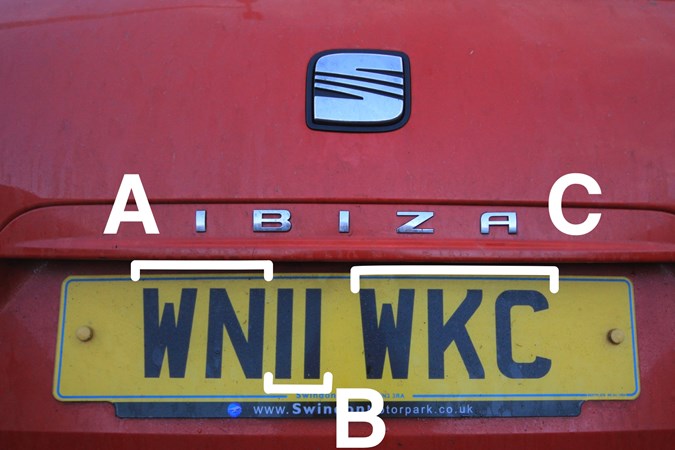
A lot of the confusion around number plate legality comes from the fact the rules have changed periodically and so certain cars, due to their age, can ‘get away’ with not complying with today’s standards all new plates need to meet. For example, before September 2001, the ‘A’ element of the registration plate was a single letter, rather than two (in other words, you’d get a plate like A123 ABC).
Since January 2021, number plates must also conform to British Standard regulation BS AU 145e, which sets the requirements out like the table below.
| Number plate legal details | Present (post-Sept 01) |
Group 1 (pre-Sept 01) |
Group 2 (pre-Jan 73) |
Motorcycles, Tricycles |
| Character height | 79mm | 89mm | 79mm | 64mm |
| Character width (Number ‘1’ or Letter ‘I’ excluded) | 50mm | 64mm | 57mm | 44mm |
| Character stroke | 14mm | 16mm | 14mm | 10mm |
| Space between characters | 11mm | 13mm | 11mm | 30mm |
| Space between age identifier & numbers i.e. gap | 33mm | 38mm | 33mm | 30mm |
| Top, bottom & side margins minimum | 11mm | 13mm | 11mm | 11mm |
| Vertical space in gap (if across 2 lines) | 19mm | 19mm | 19mm | 13mm |
Look closely at a modern number plate and you’ll also see some text along the bottom edge. This is because plates are also required to show the name or trademark of the number plate manufacturer, as well as the name and postcode of the supplier – since all suppliers have to be officially recognised, to prevent illegal suppliers and protect consumers from identity theft.
Number plate colouring has been consistent for many years now. Front registration plates need to be white with black lettering and rear plates yellow with black lettering. Cars registered prior to 1973, when the current colour system was introduced, instead feature silver or white lettering on a black background.
The font dates back to 1935, when Charles Wright created number plates for vehicles. His font is generally the accepted standard, though confusingly it has no official typeface name. Over the years there have been updates on the unofficially named Charles Wright font. Charles Wright New and more recently Mandatory make an appearance in the DVSA’s official guide to number plate legality. The subtle differences are most noticeable in the letters ‘M’ and ‘W’, where the evolution is aiming to ensure these letters can be clearly seen by ANPR. Any other font or styling, such as italics, is not permitted.
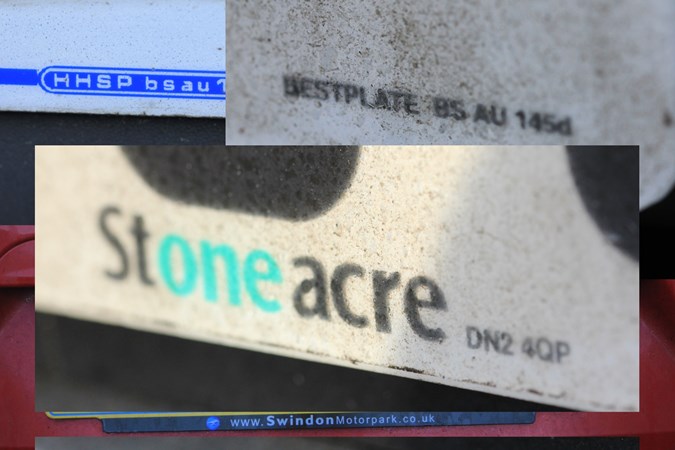
How should country identifiers be displayed?
There are specifications for how and where country flags, country abbreviations and those green stripes (denoting electric vehicles) should be.
Each of the kingdoms of the UK can display their own flags, and/or you can display CYM, ENG, GB, SCO or UK as accepted identifiers. They can be margin stickers, sitting on top of the plate, or integrated as part of the printed design, but outside of these stringent rules, no other identifiers are acceptable.
If you’re travelling abroad, most countries will accept the UK symbol integrated into the plate, negating the need for an extra UK bumper sticker (as a replacement for the old GB stickers, due to changes enacted after Brexit), but Cyprus, Malta and Spain want you to have both. Read our guide to driving in France for more information on what you need when travelling on the continent.
And those green stripes you see down the left-hand side of some number plates? Those denote electric vehicles, and are a quick identifier not just for other drivers (letting you know the car in front you’re jealously eyeing up is an EV), but also so businesses, for example, know at a glance that it’s an actual EV parking in their charging spots. Don’t think you can fix a bit of green tape to your combustion car to get preferential parking though: there are fines of up to £1,000 for improper use.
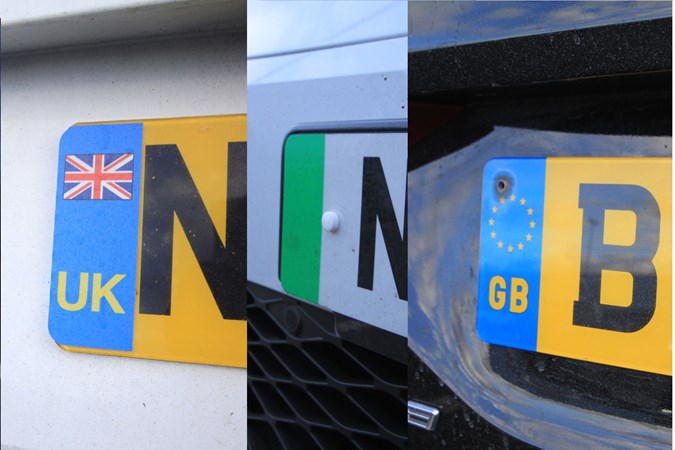
What’s not allowed then?
Visibility and reflectivity are key to your registration plate doing its job – which is to say making you and your car identifiable. Thus anything that impinges on the legibility of the number plate is likely to raise a red flag to law enforcement.
This can include, but is not limited to, moving the screws to alter the appearance of the letters, displaying a different font in a different size and not complying with the relevant spacing, as above, having the plate information across three lines instead of one, or two (for vans, motorbikes, etc.) and messing about with the colours or lights.
For reasons only known to them – we suspect to avoid being picked up by speed cameras – some drivers have attempted to make all the black letters different shades of black. It won’t surprise you to learn that the rules explicitly state ‘all one shade of black’. Likewise, filters to darken the plate are frowned upon as they reduce the contrast between the plate and the letters, while the old sprays to make the plate even more reflective, in theory causing glare when getting snapped by a speed camera, disappeared pretty quickly when people realised they didn’t work…
It should also be said that the plate has to be securely fixed in clear view on the exterior of the car, so authorities will take a very dim view of plates tucked away at an angle, or half inside vents or grilles. Putting the plate inside your windscreen or rear window is little better, since reflections contravene rules about the plate’s visibility in daylight.
What about a dirty number plate?
Yes, since running around with dirty number plates makes it harder to read your plate, you can actually be stopped and fined if muck is obscuring your plate. Granted, the winter weather can make cleaning the car seem a futile effort (but can easily be overcome with a good pre-wash).
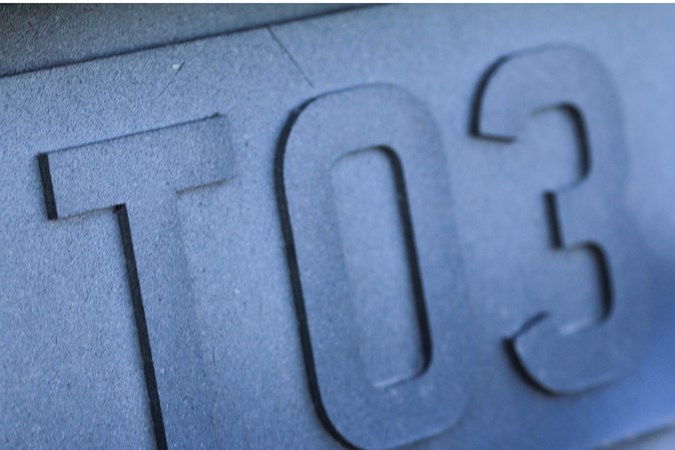
In addition to the mild inconveniences of catching your clothing on the dirt in a tight parking spot, and getting a cheeky message from a stranger written into the muck, the fine can be a grumpy £100 on-the-spot fixed penalty, or up to £1,000 once the police manage to catch up with you. Ouch. So during winter, it’s wise to keep a rag in your boot or glovebox, and give the plate a quick wipe every now and then to ensure it’s legible. Cleaning and inspecting your plate is worth doing before an MOT too, since an obscured or damaged plate can be an MOT failure.
A dirty plate can also make you more likely to be a victim of crime, so keeping your car clean with the best car shampoos or even basic waterless wash (no excuses!) has multiple advantages.
What about 3D and 4D number plates?
3D and 4D number plates can in fact be legal, although many drivers believe they’re not. However, due to the way in which they’re created, i.e. the letters and numbers are raised, 4D plates can cause problems. In brief, if the raised letters inhibits reading the plate clearly, they’re not compliant.
They’re also a bit of a pain to keep clean too, so they’re best avoided unless you’re Detailer Extraordinaire when you clean the car.
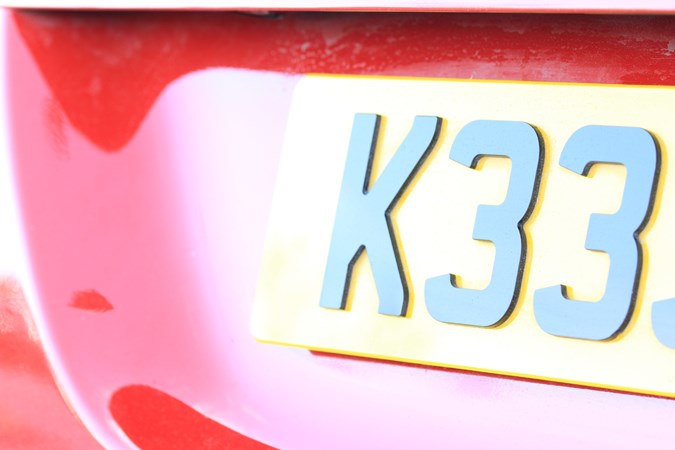
What about number plate lights?
Yes, since running around with dirty number plates makes it harder to read your plate, you can actually be stopped and fined if muck is obscuring your plate. Granted, the winter weather can make cleaning the car seem a futile effort (but can easily be overcome with a good pre-wash).
In addition to the mild inconveniences of catching your clothing on the dirt in a tight parking spot, and getting a cheeky message from a stranger written into the muck, the fine can be a grumpy £100 on-the-spot fixed penalty, or up to £1,000 once the police manage to catch up with you. Ouch. So during winter, it’s wise to keep a rag in your boot or glovebox, and give the plate a quick wipe every now and then to ensure it’s legible. Cleaning and inspecting your plate is worth doing before an MOT too, since an obscured or damaged plate can be an MOT failure.
A dirty plate can also make you more likely to be a victim of crime, so keeping your car clean with the best car shampoos or even basic waterless wash (no excuses!) has multiple advantages.
What penalties can you face for having an illegal plate?
Penalties for having an illegal plate range from a defect notice, all the way up to your car being seized. It might sound disproportionate, but the police are required to seize any evidence of an offence committed, which will best demonstrate how the offence has been committed in court. If the likelihood of conviction is higher by seizing the car, the police have the authority to do so. This can get pretty expensive, since there is a ‘release fee’ of £200, plus a storage fee of £20 per day.
In most instances, provided you’re not a repeat offender, the police will take pictures of the illegal plate and write it up as a ‘vehicle defect’, giving the driver a form called a ‘vehicle defect rectification notice’. The driver then has 14 days to correct the issue through the proper channels, which will stamp the form to confirm the work has been done. The form is then presented, within the 14-day period, at a local police station and the matter is closed.
As we mentioned above, an illegal, damaged or dirty plate could cause your car to fail its annual MOT, meaning you’ll be forced to change it at some stage.
Legitimate registration plates are often cloned by repeat offenders, out to commit crimes in your name. Innocent parties regularly end up with a miserable heap of life admin, trying to extricate themselves from the fraudulent use of their number plates. Perpetually having dirty plates could make you more susceptible to identity fraud too, since you may find it difficult to prove you were elsewhere in the country when a crime was being committed with your plates.
If you’re in doubt, your nearest certified suppliers can be found on this gov.uk webpage, and always keep your registration plates clean.
FAQs
-
What makes a number plate illegal?
A number plate is illegal if it doesn’t meet DVLA standards. This includes using the wrong font, incorrect spacing to spell names or words, or characters that are too small or too close together. Plates must be white at the front, yellow at the rear, and clearly reflective — tinted or obscured plates aren’t allowed. Legal plates must also include the supplier’s name and a British Standard number. While certain national flags are permitted, custom logos or images are not. An illegal plate can lead to a £1,000 fine and may cause your car to fail its MOT.
-
Is it illegal to have no front number plate in the UK?
Yes, it is illegal to drive without a front number plate in the UK. By law, all vehicles must display a white number plate at the front and a yellow one at the rear. Both plates must be clearly visible, securely fixed, and meet DVLA standards for font, size and spacing. Driving without a front plate can result in a fine of up to £1,000 and could lead to your vehicle failing its MOT.
-
What is the new law on number plates?
From 2025, all newly registered cars in the UK must display number plates that meet the latest British Standard (BS AU 145e). This means plates must be made from tougher, more durable materials and have a clearer, easier-to-read font to help with number plate recognition cameras. 3D or 4D lettering is still allowed, but it must meet strict visibility and reflectivity rules. Plates must also now show the supplier’s business name and postcode, plus the plate’s manufacturer and standard code.
Just so you know, we may receive a commission or other compensation from the links on this website - read why you should trust us.


